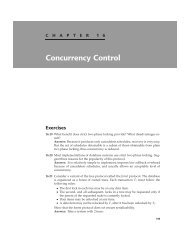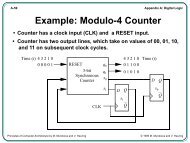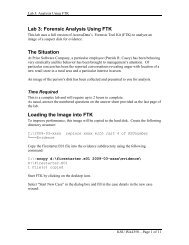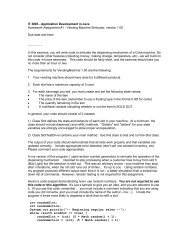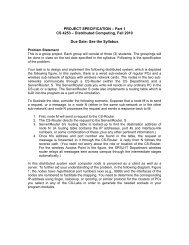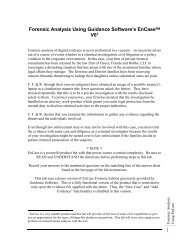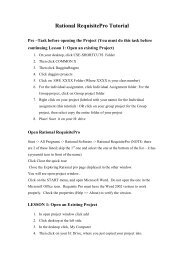You also want an ePaper? Increase the reach of your titles
YUMPU automatically turns print PDFs into web optimized ePapers that Google loves.
3.6 Reading Source Code with the CSD<br />
DRAFT, February 18, 2003, Page 39<br />
The CSD notation for each of the control constructs has been carefully designed to aid in reading and<br />
scanning source code. While the notation is meant to be intuitive, there are several reading strategies<br />
worth pointing out, especially useful with deeply nested code.<br />
Reading Sequence<br />
The visualization of sequential control<br />
flow is as follows. After statement s(1)<br />
is executed, the next statement is<br />
found by scanning down and to the left<br />
along the solid CSD stem. While this<br />
seems trivial, its importance becomes<br />
clearer with the if statement and<br />
deeper nesting.<br />
Reading Selection<br />
Now combining the sequence with<br />
selection (if.. else), after s(1), we enter<br />
the if statement marked by the<br />
diamond. If the condition is true, we<br />
follow the solid line to s(2). After s(2),<br />
we read down and to the left (passing<br />
through the dotted line) until we reach<br />
the next statement on the vertical stem<br />
which is s(4). If the condition is false,<br />
we read down the dotted line (the false<br />
path) to the else and then on to s(3).<br />
After s(3), again we read down and to<br />
the left until we reach the next<br />
statement on the stem which is s(4).<br />
Reading Selection with Nesting<br />
As above, after s(1), we enter the if<br />
statement and if cond1 and cond2 are<br />
true, we follow the solid lines to s(2).<br />
After s(2), we read down and to the left<br />
(passing through both dotted lines)<br />
until we reach to the next statement on<br />
the stem which is s(4). If the cond1 is<br />
false, we read down the dotted line (the<br />
false path) to s(4). If cond2 is false, we<br />
read down the dotted line to the else<br />
and then on to s(3). After s(3), again<br />
we read down and to the left until we<br />
reach to the next statement on the<br />
stem which is s(4).<br />
Ϩ¹¹Ïs(1);<br />
Ϩ¹¹Ïs(2);<br />
Ϩ¹¹Ïs(3);<br />
Ï<br />
ϧ<br />
Ϩ¹¹Ïs(1);<br />
Ϩ¹³´if (cond)<br />
ϧÏ6¾¹¹Ïs(2);<br />
ϧÏö´else<br />
ϧÏȾ¹¹Ïs(3);<br />
Ϩ¹¹Ïs(4);<br />
ϧ<br />
ϧ<br />
Ϩ¹¹Ïs(1);<br />
Ϩ¹³´if (cond1)<br />
ϧÏ6¾¹³´if (cond2)<br />
ϧÏ6ÏÏ6¾¹¹Ïs(2);<br />
ϧÏ6ÏÏö´else<br />
ϧÏÏÏȾ¹¹Ïs(3);<br />
Ϩ¹¹Ïs(4);<br />
ϧ



